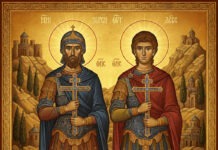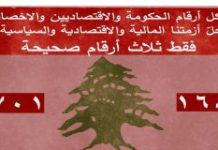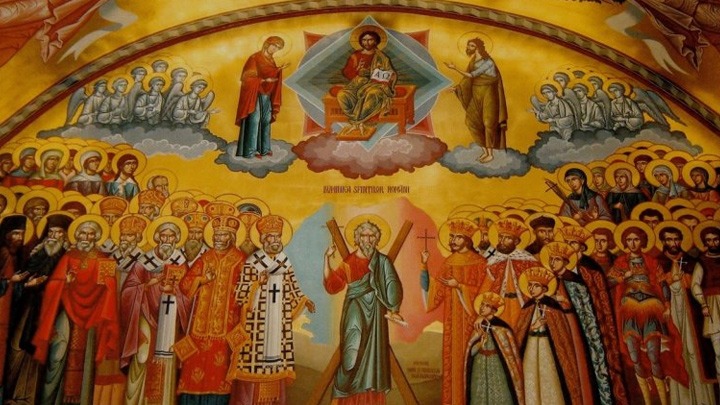The Martyrdom of the 350 Maronite Monks
Elias Bejjani/July 31/2025
الذكرى السنوية لاستشهاد 350 راهبًا مارونيًا
الياس بجاني/31 تموز/2025
شهادة من أجل المسيح والحق
في تاريخ الكنيسة المارونية محطات مضيئة سُطرت بالدم والدموع والصلاة، لكن قلّ أن نجد محطة أكثر إشراقًا وشهادة من مأساة استشهاد 350 راهبًا مارونيًا في سنة 517، على يد جيش بيزنطي بأمر من الإمبراطور “أنسطاسيوس” وبتحريض من البطريرك الهرطوقي “ساويرا الإنطاكي” ورفيقه “بطرس القصار”، لأنهم رفضوا أن ينكروا إيمانهم بعقيدة المجمع الخلقيدوني القائلة بأن في يسوع المسيح طبيعتين كاملتين: إلهية وإنسانية، متحدتين في شخص واحد.
لماذا قُتل الرهبان؟
كان الرهبان من دير بيت مارون في شمالي سوريا (قرب الحدود اللبنانية اليوم)، يتبعون تعليم القديس مارون الذي أسّس نهجًا نسكيًا وروحيًا راسخًا في العقيدة الأرثوذكسية الكاثوليكية. وعندما أعلن المجمع المسكوني الرابع في خلقيدونية عام 451 عقيدة الطبيعتين، التزم بها الموارنة ورفضوا تعاليم “أوطيخا” و”اليعاقبة” الذين ادّعوا أن في المسيح طبيعة واحدة، مما شكّل انقسامًا عقائديًا عميقًا في الكنيسة الشرقية. في عهد الإمبراطور أنسطاسيوس، شنّت حملة اضطهاد على الرهبان الكاثوليك الذين رفضوا بدعة الطبيعة الواحدة، وارتُكبت المجازر بقيادة ساويرا، الذي عُيّن بطريركًا على إنطاكية بقوة السلطة لا الإيمان.
سنة 517، وقعت الكارثة
أغلق الجيش البيزنطي الأديرة، وطرد الرهبان، واعتقل البعض، وأحرقوا دير مار مارون. وعلى الطريق إلى دير القديس سمعان العمودي، نُصب كمين للرهبان، فذُبح منهم 350 راهبًا، حتى أن بعضهم استُشهد وهو ملتجئ إلى المذبح.
توثيق الشهادة
رفع الرهبان الناجون عريضة مؤثرة إلى البابا هرميسدا (514 – 523)، يشرحون فيها ما حلّ بإخوانهم، من تعذيب ومجازر، ويطلبون دعم الكنيسة الأم. فرد البابا برسالة رعوية عام 518، عزّاهم فيها وشجعهم على الثبات في وجه الاضطهاد، مؤكّدًا اتحاد الكنيسة معهم في صلاتها ومعاناتها. وقد دوّن المؤرخون مثل تاوافانوس وتاوفيل الرهاوي الماروني تفاصيل المذبحة، معترفين ببطولة الرهبان وثباتهم الإيماني.
الشهادة في المسيحية
في المسيحية، لا تُفهم الشهادة كموت عبثي أو كخسارة، بل كتتويج للاتحاد بالمسيح الذي قال: “طوبى للمضطهدين من أجل البر، فإن لهم ملكوت السماوات” (متى 5: 10). شهداء دير مار مارون هم ليسوا فقط ضحايا ظلم، بل شهود للحق، وثمرات حية لكلمة الإنجيل. دمهم هو زُرع في أرض الكنيسة، فأنبت قديسين ومؤمنين على مدى العصور. لقد فضّلوا الموت على نكران الإيمان، ووقفوا ضد السلطة، والهرطقة، والتهديد، وهم على مذابح المحبة الإلهية.
الموارنة شعب الإيمان والنسك والتفاني
شهداء الـ 350 راهبًا هم مرآة صادقة لماهية الموارنة
هم نتاج إيمان صلب وثابت على تعليم الكنيسة الجامعة
هم عنوان نسك روحي متجذّر في الجبال والكهوف
هم رمز محبة عميقة للبنان كوطن رسالة وقداسة
عبر الأجيال، لم يتخلّ الموارنة عن عقيدتهم رغم الحصار، ولم يتنازلوا عن حريتهم الروحية رغم الحروب. كانوا شعبًا راهبًا حتى داخل بيوتهم، يزرعون صليبًا في كل حقل، ويشعلون شمعة في كل ظلمة. وإن لبنان بقي حرًا، فالفضل في ذلك لإيمان هذا الشعب وتضحيات شهدائه.
تذكار وشفاعة
تحتفل الكنيسة المارونية سنويًا في 31 تموز بتذكار شهداء دير مار مارون، وتطلب شفاعتهم. وقد عمّم البابا بندكتوس الرابع عشر الغفرانات المرتبطة بهذا العيد على جميع كنائس الطائفة المارونية. صلاتهم معنا، وإيمانهم مثال لنا. وليبقوا نورًا يهدي الطريق في زمن التحديات الروحية والكنسية.
*الكاتب ناشط لبناني اغترابي
رابط موقع الكاتب الإلكتروني
https://eliasbejjaninews.com
عنوان الكاتب الإلكتروني
phoenicia@hotmail.com
The Martyrdom of the 350 Maronite Monks
Elias Bejjani/July 31/2025
Feast Day: July 31
Among the most radiant pages in the history of the Maronite Church is the martyrdom of 350 monks from the Monastery of St. Maron in 517 AD. These monks were brutally killed by order of the Byzantine Emperor Anastasius, under the instigation of the Monophysite Patriarch Severus of Antioch and his ally Peter the Fuller. Their crime? Upholding the doctrine of the Council of Chalcedon, which affirmed that Jesus Christ is both fully divine and fully human, united in one person.
Why Were They Killed?
The monks of St. Maron, spiritual descendants of St. Maroun, lived in northern Syria near the border of modern-day Lebanon. They were deeply committed to Catholic orthodoxy, especially the teaching of the Council of Chalcedon (451 AD), which declared that Christ is one person in two complete and distinct natures: divine and human. This doctrine was rejected by the Monophysites, who claimed that Christ had only one divine nature. Emperor Anastasius, a supporter of Monophysitism, empowered Severus to persecute those who remained loyal to Chalcedonian orthodoxy. In 517, imperial soldiers swept through the district of Apamea, shutting down monasteries and targeting faithful monks. Many were beaten, imprisoned, or exiled. On their way to the Monastery of St. Simeon Stylite, 350 Maronite monks were ambushed and slaughtered, even as some clung to the altar. The monastery itself was then set ablaze.
A Witness Recorded in Rome
The surviving monks wrote a powerful letter to Pope Hormisdas (514–523), recounting the horrors they had witnessed and endured at the hands of Severus and his followers. In 518, the Pope replied with a message of comfort and strength, praising their steadfastness and encouraging them to persevere in the true faith.
Church historians—including Theophanes and Theophilus of Edessa, a Maronite—confirmed the massacre, documenting the persecution and execution of the Chalcedonian monks.
The Meaning of Martyrdom in Christianity
In the Christian tradition, martyrdom is not defeat—it is a triumph of truth, love, and unwavering faith. Jesus taught: “Blessed are those who are persecuted for righteousness’ sake, for theirs is the kingdom of heaven.” (Matthew 5:10). The 350 monks were not merely victims of violence; they were witnesses to eternal truth. Their blood was not spilled in vain—it nourished the very roots of the Maronite Church and sustained the flame of orthodoxy across centuries. Their martyrdom remains a sacred legacy of faithfulness, resistance, and spiritual heroism.
The Maronites: A People of Faith, Asceticism, and Sacrifice
The 350 martyred monks are a faithful mirror of the Maronite identity.
They are the fruit of an unshakable faith grounded in the teachings of the universal Church.
They are the embodiment of spiritual asceticism, rooted in mountains, caves, and silence.
They are a symbol of profound love for Lebanon—as a land of divine mission and sacred purpose.
Through every generation, the Maronites have never forsaken their faith, even under siege. They never surrendered their spiritual freedom, even during war. They have been a monastic people, even within their homes—planting a cross in every field and lighting a candle in every darkness. If Lebanon remains free today, it is thanks to the faith of this people and the sacrifices of its martyrs.
Maronites have remained inseparably tied to Lebanon
The Maronites have always been devoted to prayer, monastic life, and steadfast loyalty to Christ and His Church. They have remained inseparably tied to Lebanon, seeing in it not just a homeland but a holy mission.
Despite persecution, exile, and war, they held tightly to their faith and to the land. Their story is not only one of survival—it is a testament of sacrificial love. In every cave they built a chapel; in every valley they sowed the seeds of resurrection.
Remembrance and Intercession
On July 31, the Maronite Church commemorates the 350 Martyrs of St. Maron Monastery. In recognition of their sacrifice, Pope Benedict XIV extended the indulgences associated with this feast to all Maronite churches, following the example of Pope Clement XII in 1734.
May their prayers sustain us.
May their courage inspire us.
And may we never abandon the truth for which they laid down their lives.




















